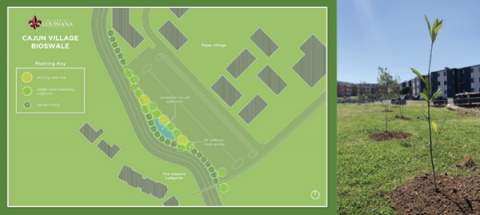Impact of Trees on Campus

Trees are much more than an admirable landscape feature; trees help to combat heat effects, improve air quality, absorb abundant rainwater, and promote biodiversity. In the Fall of 2021, the Office of Sustainability was awarded a grant of 150 adolescent trees. This award sparked an initiative to seek out areas on campus that could benefit from the positive effects of trees. These trees were planted in the 2022 Fall semester behind Cajun Village along the coulee and parking lot.
The Trees
When selecting trees, it was important for the office to choose native species. Native trees promote biodiversity of local ecologies far better than foreign species. The trees selected through the grant were: Single-stem Sweetbay Magnolias, Red Maples, Dahoon Hollies, Willow Oaks, and Nuttall Oaks.
Urban development is one of the leading factors of heat island effects. Large areas of concrete, like parking lots, offer very little relief from solar radiation or high rainwater levels. The Cajun Village parking lot and coulee proved to be an excellent site for tree plantings. Once fully grown, the mix of Sweetbay Magnolias and Dahoon Hollies will provide shade to combat the radiant heat from the parking lot, as well as prevent flooding by absorbing excessive rainwater.
The Impact
- Trees eat the greenhouse gases that cause climate change—for breakfast.
- Trees boost our mental health and can even help us concentrate.
- Trees clean the air so we can breathe more easily. Trees suck up CO2 and put out oxygen for us to breathe.
- Trees give a home to the wildlife we love.
- Trees temper climate. Trees lower air temperatures and humidity – which is needed in Louisiana.
- Trees filter your water, making your drinking supply cleaner and more reliable.
- Trees can provide food.
- Trees can help reduce flooding by absorbing excess water in rainfall event.
As a reconized Tree Campus USA university we are deadicated protecting and planting trees around campus to improve our Campus Forestry efforts.
Source: The Nature Conservancy
